Subterranean Splendour: The Underground Cities of Cappadocia

Updated On: April 04, 2024 by Raghda Elsabbagh
Nestled within the rugged landscape of central Türkiye, the underground cities of Cappadocia emerge as one of history’s most magnificent subterranean wonders. These cities, carved from the region’s soft volcanic rock, are an architectural marvel and an unforgettable testament to human ingenuity. With a history that stretches back as far as the eighth and seventh centuries BCE, when the Phrygians likely began the construction of these complex habitats, Cappadocia’s underground cities offer a portal into a past where communities thrived beneath the Earth’s surface.
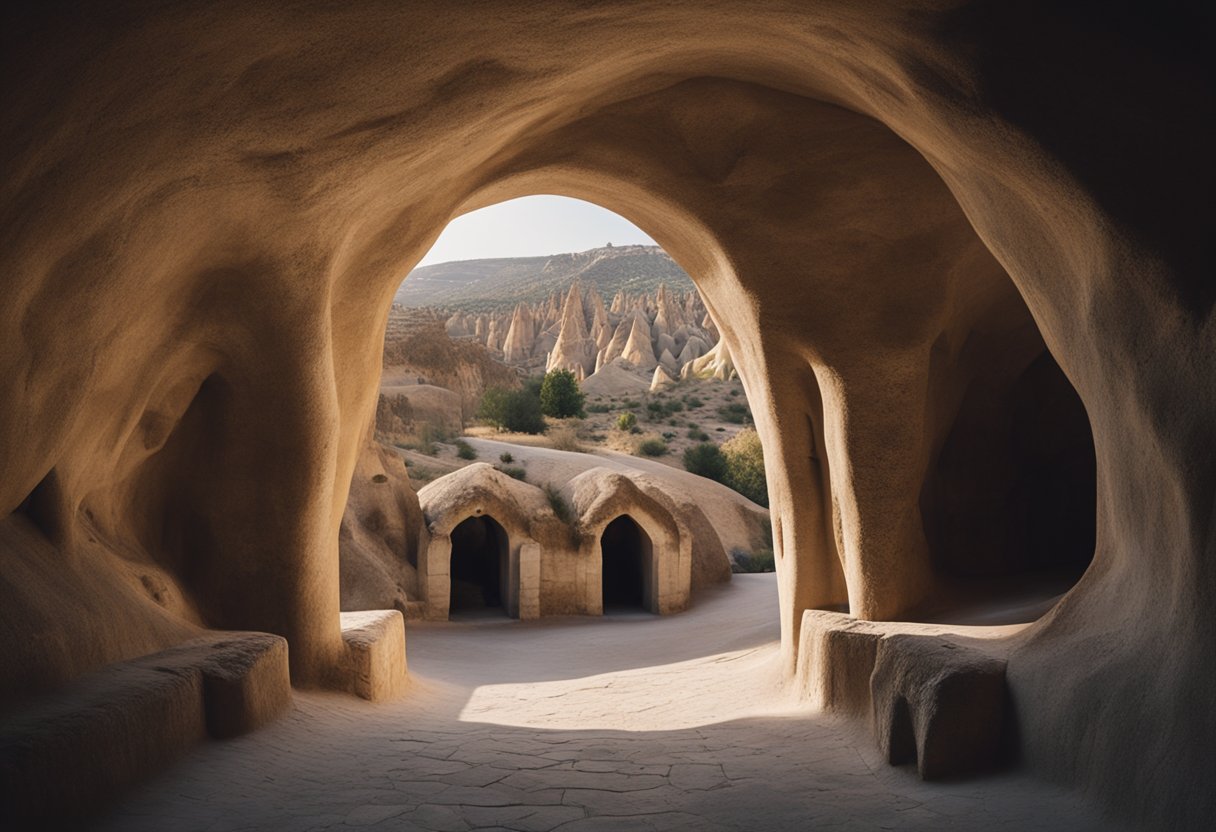
Over centuries, these underground cities expanded, serving multiple purposes and offering protection against invaders. The largest excavations, such as Derinkuyu and Kaymaklı, allowed ancient inhabitants to practice their religion, live daily life, and defend themselves with ingeniously designed security features. Today, these cities are UNESCO World Heritage Sites and significant tourist attractions, bridging the past with the present, allowing us to walk in the footsteps of those who once sought refuge within this labyrinth of tunnels and chambers.
Table of Contents
Geography and Climate of Cappadocia
Cappadocia is a region that boasts a unique topography sculpted from volcanic rock, creating landscapes of wonder. Here, we explore the remarkable natural structures and the climatic elements that have shaped the history of this storied land.
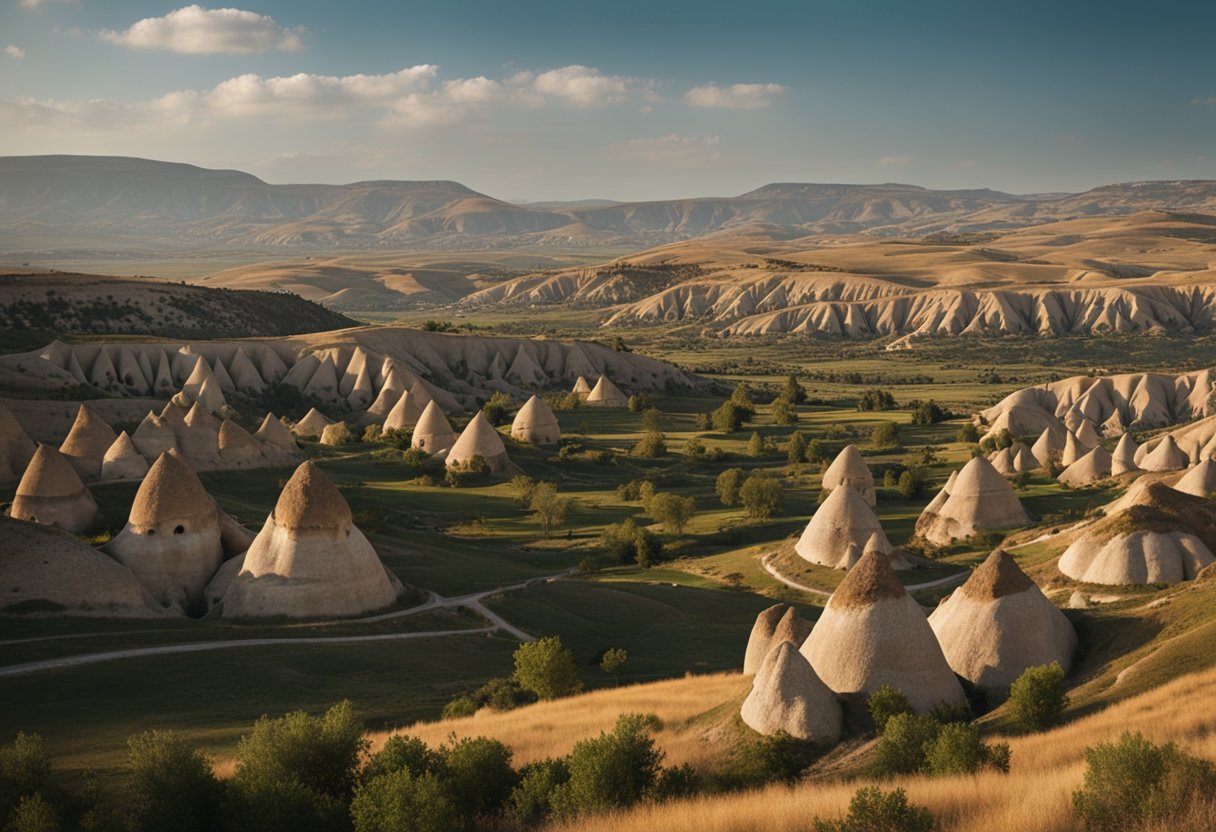
Unique Landscapes and Formations
The Cappadocia region is celebrated for its extraordinary geological phenomenon, “fairy chimneys.” These tall, cone-shaped rock formations are clustered in Monks Valley, near Göreme and other regional areas. Remarkably, these formations result from volcanic eruptions that covered the area in thick ash, which solidified into a soft rock called tuff. Over time, erosion crafted these unique structures, forming what are now the iconic landscapes of Cappadocia. In places like Göreme, these fairy chimneys have been hollowed out to create houses, storerooms, and churches, which are integral to the historical fabric of the area.
Climate and Environmental Factors
The climate of Cappadocia can be extreme, with hot and dry summers followed by cold and snowy winters. This continental climate has influenced human settlement throughout the region’s history. Crucial to the sculpting of the landscapes, environmental factors like wind and water erosion have further contributed to the evolution of Cappadocia’s terrain. The resulting terrain is a testament to the region’s natural history—a history etched in the soft volcanic rock—utilised by past civilisations and admired by visitors today.
Historical Overview of the Underground Cities of Cappadocia
In this historical overview, we’ll explore the evolution of the underground cities of Cappadocia from their earliest days to the modern era, touching on their significance during different periods in history.
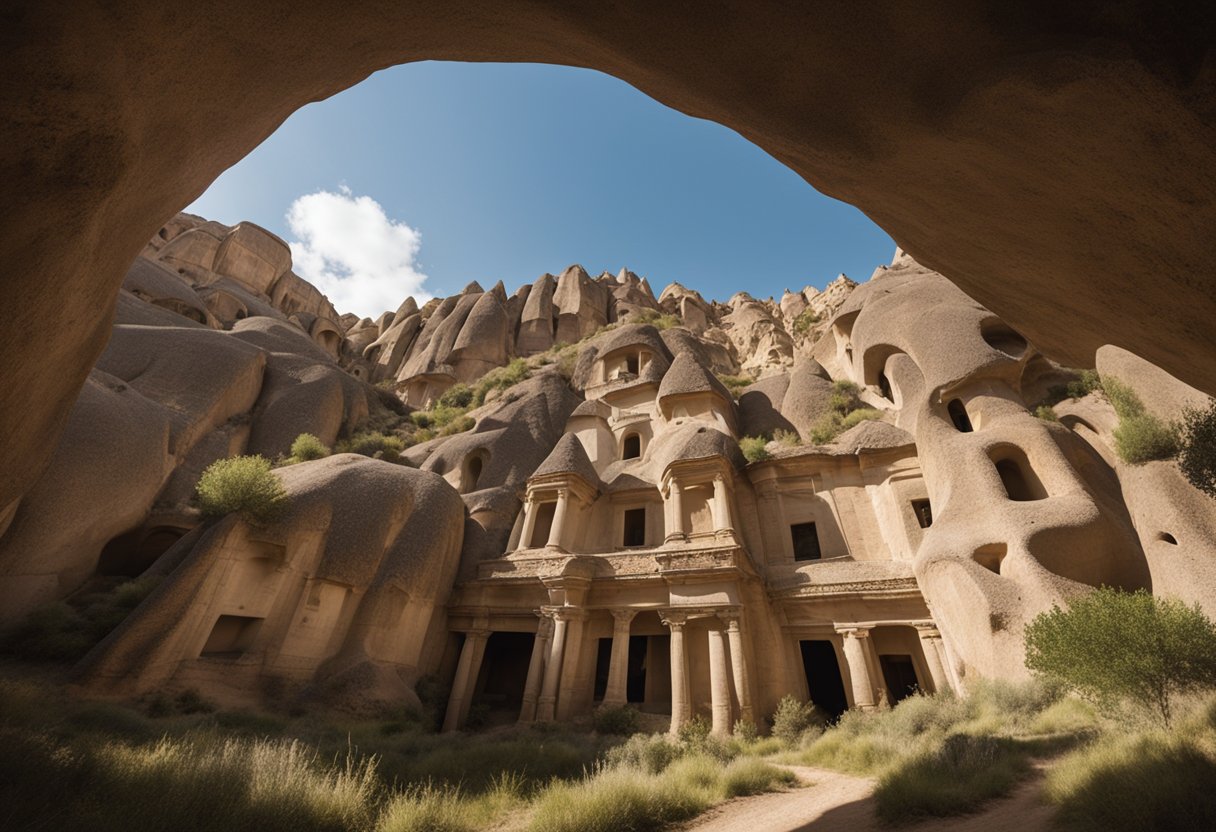
Early Inhabitants and Hittite Period
The region of Cappadocia, known for its unique rock formations and expansive underground cities, has been inhabited since the Neolithic era. Over time, it became the domain of the Hittites, an ancient Anatolian people who contributed significantly to Cappadocia’s early development. The underground cities, such as those found in Kaymaklı and Derinkuyu, were initially carved out by the Phrygians in the 8th and 7th centuries BCE, following the decline of the Hittite Empire. This construction provided protection and secrecy, vital for the survival of its inhabitants in times of invasion and conflict.
Roman and Byzantine Influence
The strategic position of Cappadocia drew the interest of both Rome and the Byzantine Empire, as the region became a pivotal area due to its natural defences and hidden shelters. During the Roman and early Byzantine periods, the cities continued to expand to accommodate growing populations and serve as sanctuaries for early Christians fleeing persecution. Under the Byzantines, these subterranean complexes were further developed, including the addition of chapels and monastic communities carved into the stone with impressive artistry.
Ottoman Empire to Modern Day
As the Ottoman Empire expanded into Anatolia, Cappadocia maintained its cultural and historical significance. Yet, the underground cities fell into relative obscurity. It wasn’t until recently that these subterranean marvels captured the world’s imagination, drawing attention to the region again. Our understanding and appreciation of these cities have grown, and they’ve become a testament to Türkiye’s rich history, attracting tourists and researchers keen to uncover their secrets. Today, the underground cities of Cappadocia are crucial to the story of human ingenuity and resilience, a narrative we are still discovering.
Cappadocia has been a silent witness to the march of empires and the evolution of civilisations from the Hittites to modern Türkiye through these periods. The underground cities reflect the rich tapestry of history carved into the stone of this extraordinary landscape.
Subterranean Architecture
Cappadocia’s underground cities exhibit intricate subterranean architecture, remarkable for its time and reflecting the ingenuity of ancient civilisations. Through clever engineering and detailed stonework, entire communities could thrive beneath the Earth’s surface.
Engineering and Construction
The construction of the underground cities of Cappadocia was a herculean task which required skilful planning and execution. The cities, like Derinkuyu, were expertly hewn from soft volcanic rock into a complex labyrinth of tunnels and chambers, demonstrating advanced knowledge of ancient architecture. These multi-levelled constructs could go as deep as 85 metres, incorporating residential areas, communal spaces, and livestock pens.
The sophisticated ventilation system that allowed fresh air to reach even the deepest levels was key to their functionality. This was achieved by excavating intricately planned air shafts that also served to regulate temperature. In addition, seismic tomography suggests that positioning supporting pillars and walls was deliberate to ensure stability in an earthquake-prone region.
Stone Work and Carvings
As for the aesthetic and practical aspects of their stonework, the citizens of these underground cities carved out everything needed for daily life from the surrounding rock. This included furniture such as tables and benches, which were integrated directly into the architecture, conserving valuable space.
Stone doors, massive round rock slabs, could be rolled across passageways to secure entrances against intruders. The attention to detail in the carvings of each chamber’s walls and ceilings also reflects a cultural commitment to creating a livable and, in many ways, beautiful domestic space despite the underground setting. These features are practical and bear the marks of a civilisation that sculpted its history into the very walls surrounding it.
The Network of the Underground Cities of Cappadocia
Cappadocia boasts a complex network of ancient underground cities, each with its own unique features and histories. Carved by human hands, these subterranean marvels provided shelter, safety, and a bustling community life centuries ago. We will explore some of the most remarkable of these cities, their structure, and the ingenuity behind their construction.
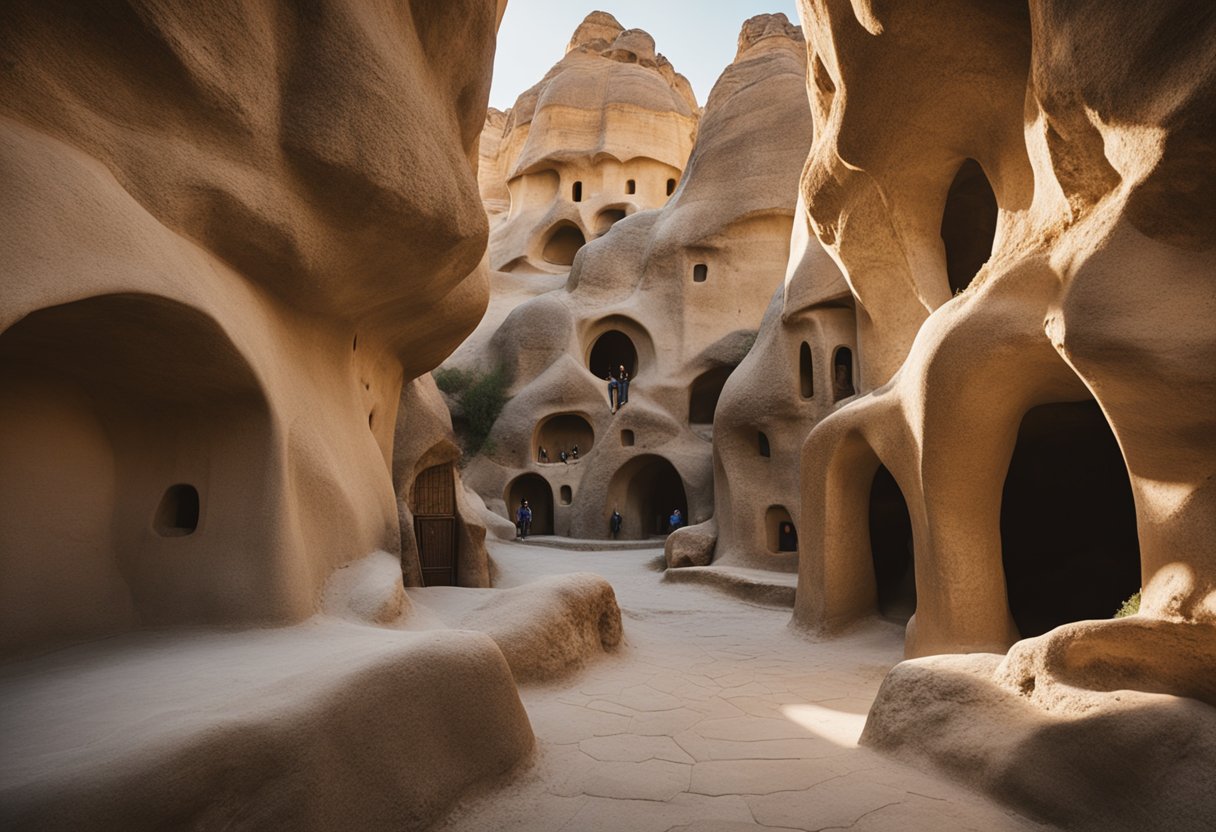
Derinkuyu: A Multi-Level Marvel
Derinkuyu stands as an astonishing example of underground architecture illustrating sophisticated urban planning. This city plunges to approximately 85 metres, encompassing eight levels below the surface with elaborate tunnel systems. It could accommodate thousands of people and had all the facilities needed for extended periods underground, including ventilation shafts, storerooms, water wells, communal areas, and chapels. The ingenuity of its design is a testament to the adaptability and resourcefulness of its ancient builders.
Kaymaklı: Interconnected Living Spaces
While not as deep as Derinkuyu, Kaymaklı is distinguished by its extensive interconnected rooms and passages network. The city features multiple floors, each space and level thoughtfully positioned to ensure the community can function effectively, from residences and communal areas to livestock pens and wine cellars. These interconnected spaces exemplify how the inhabitants valued community and accessibility.
Özkonak and Other Notable Cities
In addition to Derinkuyu and Kaymaklı, there are other significant underground cities, such as Özkonak. Smaller in scale, it is nonetheless impressive with its communication system of pipes and unique security features, such as holes to pour hot oil on invaders. Numerous other underground cities in Cappadocia boast similar complex designs, highlighting an extensive and sophisticated network of human habitation beneath the Earth’s surface.
Daily Life Under the Ground
In the Cappadocia region, the subterranean landscapes are a testament to human ingenuity. The vast network of caves includes everything necessary for a self-sufficient community.
Livestock and Agriculture
Within these underground cities, livestock played a crucial role in sustaining life. Stables, essential for food and labour, were carved out for animals. They positioned these near the entrance to facilitate air circulation and waste removal. Agriculture was also adapted to the underground environment; food storage areas kept harvests from the surface viable for extended periods.
Religious and Social Spaces
The residents of the underground cities of Cappadocia valued their communal and spiritual life deeply. They constructed chapels and places of worship, often adorned with frescoes, signalling a strong adherence to their faiths. Social interactions occurred in designated areas, usually large rooms interpreted as community centres. These spaces also included schools, where education and cultural knowledge were imparted to the young. The well-designed layout of these areas enabled inhabitants to continue essential social functions despite the constraints of their subterranean setting.
Byzantine Era and Christianity
The underground cities of Cappadocia are a testament to the Christian communities that sought refuge during the Byzantine era. These underground structures provided shelter and served as religious centres, with chapels and monastic complexes adorned with intricate frescoes.
Religious Significance and Monasteries
During the Byzantine era, Christianity was an integral part of society, and the underground cities of Cappadocia became pivotal in sustaining the faith. Numerous monasteries are carved into the rock, indicating a monastic life deeply entrenched in spiritual devotion and study. These sites often featured frescoes that depicted scenes from the Bible, reflecting the religious fervour of the time.
Several Byzantine-era frescoes have withstood centuries, displaying the iconography and artistry that characterised early Christian worship. The rock-carved monasteries were not just places of seclusion; they became beacons of Christianity, educating monks and laypeople alike through their vivid religious art.
Persecution and Safe Havens
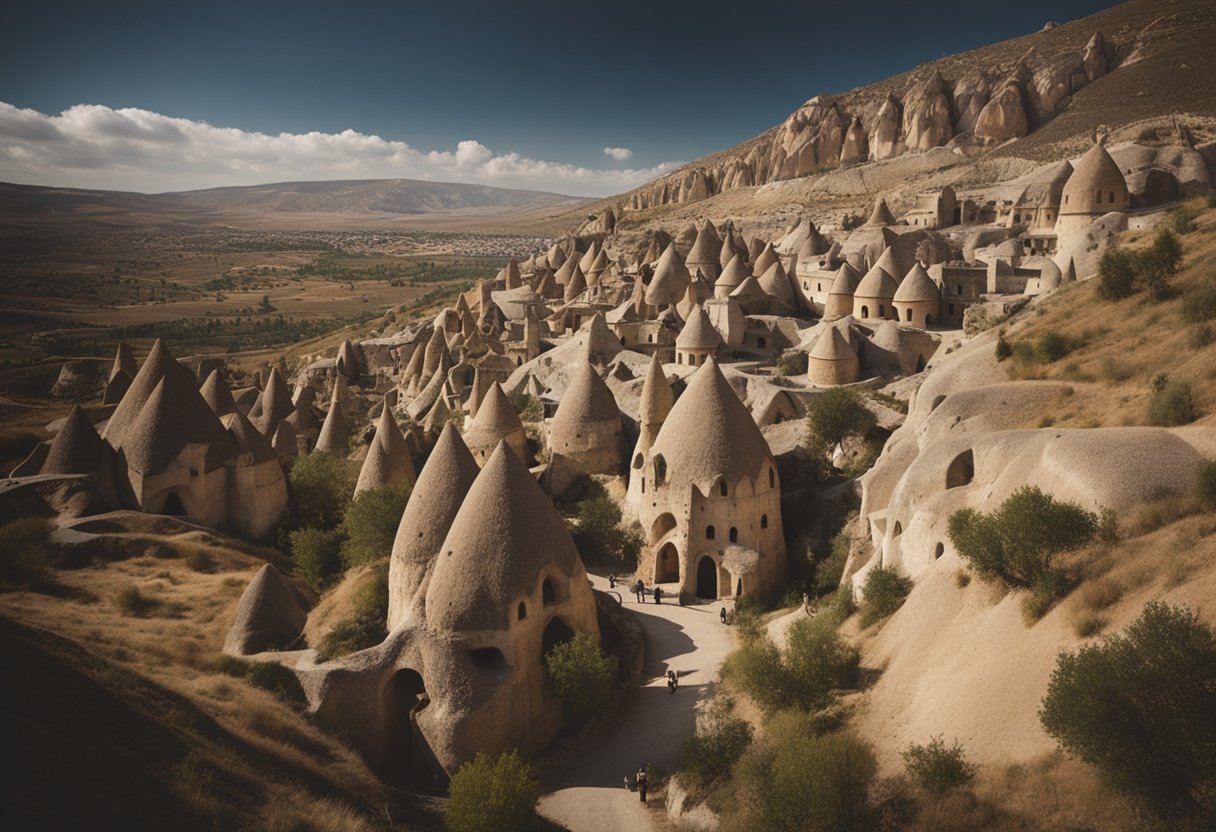
The political struggles of the Byzantine Empire, particularly during times of religious persecution, drove early Christians to seek refuge underground. These subterranean dwellings and complexes provided safe havens from external threats, particularly during the Arab-Byzantine wars.
The inhabitants employed a series of tunnels, hidden entrances, and strategic defences to protect their communities, faith, and way of life. Excavations in the region have unearthed evidence of entire cities capable of sustaining life for extended periods, showcasing the ingenuity and resilience of these Byzantine-era Christians in the face of adversity.
The Role of the Underground Cities of Cappadocia in Defence
The underground cities of Cappadocia served as formidable defences against invasions throughout history. These underground cities combined natural and man-made elements to provide shelter and fend off threats.
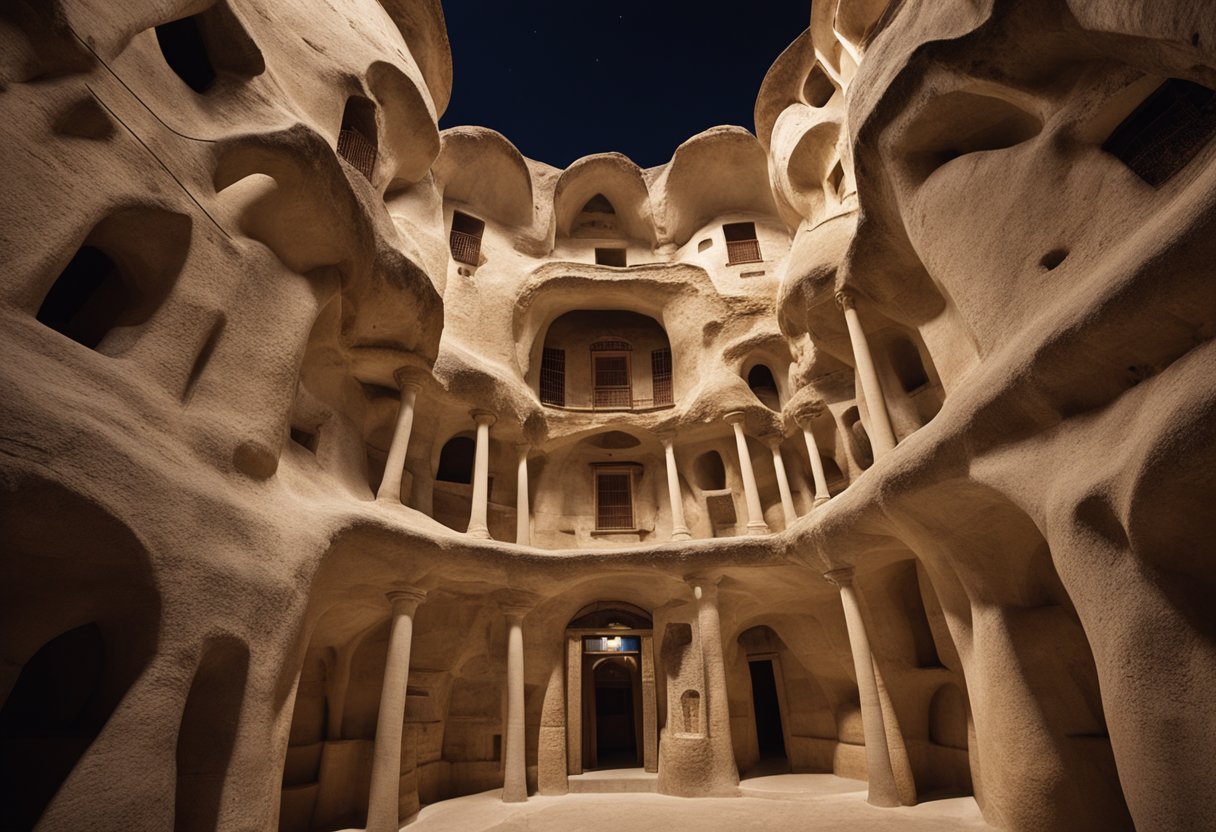
Shelter from Invasion
The underground cities in Cappadocia offered inhabitants a secure refuge during times of conflict. With the constant threat of invasion, these extensive networks of tunnels and rooms, hidden beneath the Earth’s surface, provided vital shelter for entire communities. The ability to retreat to these subterranean fortifications meant that locals could survive for extended periods without the need for surface resources.
Ingenious Defence Mechanisms
Ancient engineers incorporated remarkable defence mechanisms into these underground sanctuaries. Ventilation systems were ingeniously designed, with discreet air shafts ensuring fresh air circulation, even when entrances were sealed. Not only did these systems sustain life, but they also prevented invaders from smoking out the occupants. Furthermore, elaborate tunnel systems allowed for the movement between different levels and sectors of the cities, facilitating communication and the transport of goods without exposure to the outside world. These features highlight the sophistication and strategic foresight of the builders in protecting inhabitants from harm.
Cultural Heritage and Preservation
Before we delve into concrete efforts to preserve Cappadocia’s subterranean marvels, it is pivotal to acknowledge their global recognition as spectacular testimonies to cultural heritage and the concerted endeavours made to sustain their legacy.
UNESCO World Heritage Status
In 1985, the Göreme National Park and the Rock Sites of Cappadocia, encompassing their underground cities, were proudly inscribed on the UNESCO World Heritage List. This inscription signifies the extraordinary universal value of Cappadocia’s natural and cultural landscape. It aligns it with an international commitment to its safeguarding. The recognition by UNESCO reaffirms the significance of the region not only as a national treasure of Türkiye but as a patrimony of the entire world, entrusting us with the mission to protect and celebrate this cultural heritage.
Conservation Efforts
Preservation of the unique heritage of Cappadocia requires meticulous and ongoing conservation efforts. Initiatives undertaken by Turkish authorities, often in partnership with international organisations, focus on maintaining the structural integrity of rock formations and man-made structures. Efforts such as controlled access and environmental management ensure the delicate balance between tourist accessibility and preservation. Being a UNESCO World Heritage Site comes with the responsibility to uphold rigorous conservation standards, ensuring that the underground cities of Cappadocia endure for future generations to experience and appreciate.
Tourism and Modern Relevance
The Underground Cities of Cappadocia are a testament to the region’s rich history and continue to play a significant role in local tourism and economy. These ancient marvels are living venues that captivate visitors from around the world.
Visiting Cappadocia: Tours and Tips
When we explore Central Türkiye, the Göreme and Ürgüp areas serve as popular starting points for delving into the underground wonders of Cappadocia. The Avanos district, known for its pottery and proximity to the underground cities, is another must-visit location. While independent exploration is possible, joining a 12-day group tour often provides a structured and in-depth experience, covering key highlights and hidden gems that may be missed when travelling solo.
Entrance fees to the underground cities are nominal, ensuring that the wonders of Cappadocia remain accessible to all travellers. For convenience, here’s a quick list of essentials for touring these ancient cities:
- Comfortable walking shoes
- A light jacket (temperatures can be cooler underground)
- Cash for entrance fees
- Ample storage on your camera or phone
Impact on Local Economy
Cappadocia’s underground cities are a cornerstone of the region’s economy, with tourism significantly contributing to the livelihoods of local communities. The influx of visitors to sites such as Kültepe and Kanesh supports many businesses, from traditional accommodation options like cave hotels to restaurants and local artisans.
The popularity of these ancient sites as a tourist attraction boosts employment in the service industry, including guides, drivers, and hospitality staff. By choosing to stay in the region’s unique cave hotels or purchase local handicrafts, tourists play a crucial part in sustaining the area’s cultural heritage and ensuring economic vitality for its residents.
Cappadocia beyond the Underground
As we uncover the treasures of Cappadocia, it’s not just the depth of its underground cities that captivates us; the surface tells its own story of cultural richness and historical depth. Balancing the covert marvels below, the above-ground features of Cappadocia’s landscape offer an equally fascinating glimpse into a past civilisation’s everyday life and their artistic expressions.
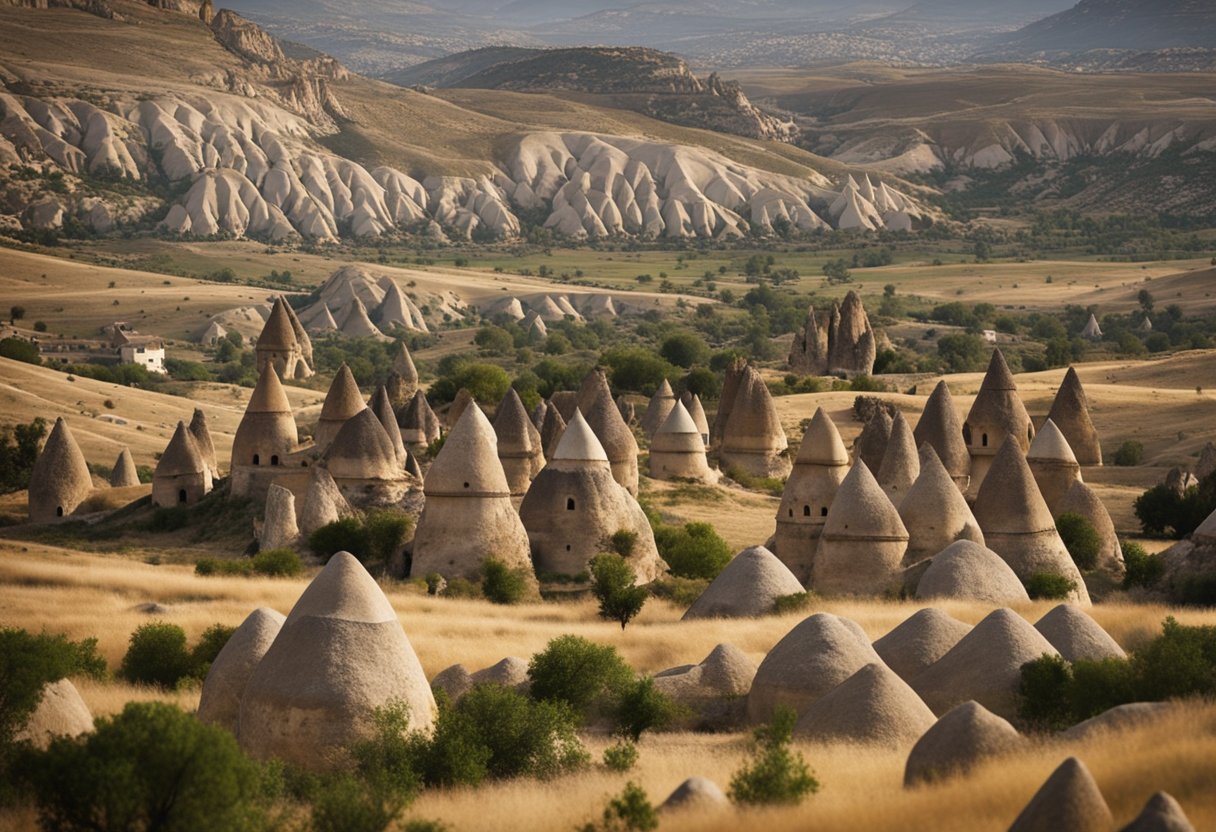
Surface Dwellings and Structures
The remarkable landscapes of Cappadocia are punctuated with iconic fairy chimneys and geological formations that have been shaped over centuries. Many rock spires have been hollowed out and converted into homes, churches, and stores. The Ürgüp region, renowned for its cave dwellings, invites visitors to explore these structures seamlessly blending into the natural environment. In the various valleys, several outdoor museums display intricate frescoes inside rock-cut churches. Here, tombs and temples excavated from the rock stand as a testament to the ingenuity of ancient stoneworkers.
- Ihlara Valley: A notable example featuring a 100m-deep canyon lined with rock-cut monastic complexes.
- Göreme Open Air Museum: Home to some of the most impressive rock-carved churches and frescoes dating back to the 10th century.
- Zelve Open Air Museum: Boasts various cave houses, religious, and secular chambers.
Arts and Wineries of the Region
While rooted deeply in its historical significance, Cappadocia continues to be a hub for local arts as the region’s inhabitants carry forward their ancestral crafts. The area’s galleries are replete with exquisite pieces that reflect the quintessential aesthetics of the locale.
- Pottery and Ceramics: A craft that has thrived in the Avanos district, drawing on the region’s rich clay deposits from the Kızılırmak River.
- Textile Art: Utilising traditional methods and patterns, local artisans create stunning textiles that tell a story through their weaves.
Moreover, the region’s fertile volcanic soil is ideal for winemaking, a tradition that Cappadocia has cultivated for centuries. Our local wineries open their doors to enthusiasts eager to sample the unique flavours that can only be attributed to this region’s distinctive terroir.
- Tasting Tours: Offering an array of reds, whites, and rosés, each winery presents an immersive experience into the area’s viticulture.
- Wine Production: Embracing both traditional and modern methods, the wineries balance respect for history with contemporary innovation.
Through exploring these aspects, Cappadocia reveals itself as an ancient subterranean wonder of the enduring human spirit, expressed in stone, art, and the very soil that nurtures it.
Have you visited Cappadocia before? Tell us about your experience.






